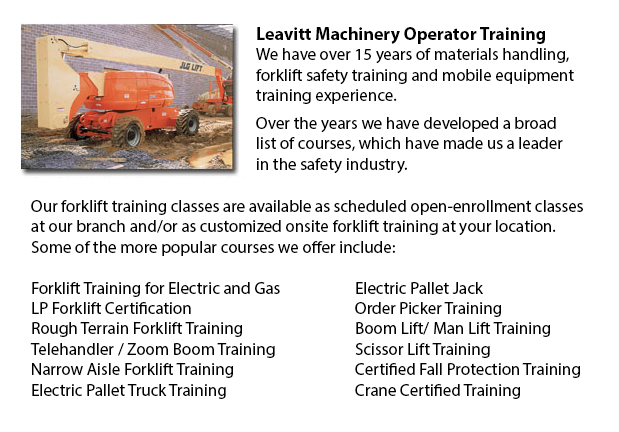
Aerial Lift Safety Training Richmond Hill - Every year, there are about 26 construction deaths attributed to the utilization of aerial lifts. Nearly all of the craftsmen killed are electrical workers, laborers, painters, ironworkers or carpenters. Nearly all fatalities are caused by falls, tip-overs and electrocutions. The greatest hazard is from boom-supported lifts, like for instance bucket trucks and cherry pickers. The majority of the fatalities are related to this particular kind of lift, with the rest involving scissor lifts. Other dangers comprise being thrown out of a bucket, being struck by falling objects, and being caught between the lift bucket or guardrail and an object, like a steel beam or joist.
The safe operation of an aerial lift requires an inspection on the following things before making use of the device: emergency and operating controls, safety devices, personal fall protection gear, and wheels and tires. Check for possible leaks in the air, hydraulic fluid and fuel-system. Inspect the device for loose or missing parts.
The area where the device will be used should be thoroughly inspected for potential dangers, like for instance bumps, holes, debris and drop-offs. Overhead power lines must be closely monitored or avoided. It is suggested that aerial lift devices be utilized on level, stable surfaces. Don't work on steep slopes that go beyond slope limits specified by the manufacturer. Even on a level slope, wheel chocks, outriggers and brakes should be set.
Companies must provide their aerial lift operators with the right instruction manuals. Mechanics and operators should be trained by a licensed individual experienced with the relevant aerial lift model.
Aerial Lift Safety Guidelines:
o Close doors or lift platform chains prior to operating.
o Do not lean over or climb on guardrails. Stand on the floor of the bucket or platform.
o Use the provided manufacturer's load-capacity limits.
o When working near traffic, utilize appropriate work-zone warnings, like for example signs and cones.
Electrocutions are preventable if safety procedures are followed. Stay well away from power lines - at least 10 feet. Trained electrical workers must insulate and/or de-energize power lines. Workers should utilize personal protective tools and equipment, like insulated bucket. Nevertheless, a bucket which is insulated does not protect from electrocution if, for example, the worker touches another wire providing a path to the ground.
Falls are avoidable if the worker remains secure in guardrails or in the bucket by using a full-body harness or a positioning device. If there is an anchorage inside the bucket, a positioning belt with a short lanyard is adequate.
Tip-overs are preventable by following the manufacturer's directions. Unless otherwise specified by the manufacturer, never drive when the lift platform is elevated. Adhere to the device's vertical and horizontal reach limitations, and never go beyond the specified load-capacity.
-
Scissor Lift Certification Richmond Hill
Scissor Lift Certification Richmond Hill - Scissor lift platforms are utilized at work sites in order to allow tradespeople - like for example welders, masons and iron workers - to reach their work. Operating a scissor lift platform is usually second... More -
Narrow Aisle Forklift / Order Picker Training / Electric Pallet Jack / Electric Pallet Truck Training in Richmond Hill
A pallet jack is a model of equipment specialized in the transporting of pallets of many dimensions and weights. They might be utilized as an appendage for lift trucks, cranes and other types of heavy machinery or be used on their own. Pallet jacks a... More -
Heavy Equipment Operator Certification Richmond Hill
Heavy Equipment Operator Certification Richmond Hill - The heavy equipment operator is a person who manipulates the controls and drives various kinds of big machinery. Heavy machinery is most frequently used on construction sites in order to deliver... More -
Loader Training Richmond Hill
Loader Training Richmond Hill - Why You Must Finish A Loader Training Course - Individuals wanting work in businesses that use lift trucks must undergo a Loader Training program prior to becoming a certified operator of a lift truck. There are lots o... More -
Manlift Training Richmond Hill
Manlift Training Richmond Hill - Various manlift training programs consist of the review and content of manlift devices. An important part of the course is the practicum where students show their knowledge and practical ability to safely operate a ma... More -
Fall Protection Training in Richmond Hill
There are many injuries at work associated to falling and a lot of fall-related deaths reported every year. Most of these instances could have been prevented with better training, better measures in place, and by correctly equipping personnel before... More -
Wheel Loader Training Richmond Hill
Wheel Loader Training Richmond Hill - Commonly, the various kinds of heavy equipment training are classed into 2 categories of machinery: those which have rubber tires and tracked vehicles. Tracked vehicles consist of items like cranes, bulldozers an... More -
Forklift Certification Schools Richmond Hill
Forklift Certification Schools Richmond Hill - Forklift Certification is mandatory in North America. Hence, forklift training programs are important both for companies and for people seeking jobs in industries as forklift operators. Forklift training... More

Forklift Training Richmond Hill
TOLL FREE: 1-888-254-6157
Richmond Hill, Ontario
forklifttrainingrichmondhill.com
Email Us
About Us


